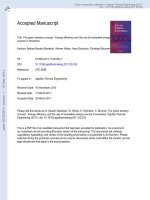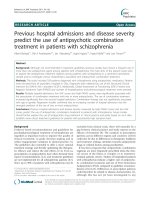The use of role play activities in enhancing 10th graders’ motivation and speaking performance at Nam Cao High School
Bạn đang xem bản rút gọn của tài liệu. Xem và tải ngay bản đầy đủ của tài liệu tại đây (144.74 KB, 5 trang )
The use of role play activities in enhancing 10
th
graders’ motivation and speaking performance
at Nam Cao High School
Trần Thị Phấn
Trường Đại học Ngoại ngữ
Luận văn ThS. Chuyên ngành: English teaching methodology; Mã số: 60 14 10
Người hướng dẫn: Dr. Đỗ Tuấn Minh
Năm bảo vệ: 2013
Keywords: Tiếng Anh; Phương pháp giảng dạy; Kỹ năng nói; Lớp 10
Content
PART A: INTRODUCTION
1. Rationale of the study
Nowadays, English has become one of the most important languages in the world.
Especially in the globalization trend, it is spoken as a second language and an official language
in many countries, and as a foreign language in the global world as well. Almost all the people
from many different countries around the world use it to communicate. At high schools in the
whole country, English is now a compulsory subject for all students. In traditional teaching,
students were required to acquire English grammar; however, nowadays in the light of
Communicative Language Teaching (CLT), they are required to acquire various skills and
language items. In the international relationship, English speaking ability is very important for
people to be able to integrate into the wide world. The speaking skill is measured in terms of the
ability to carry out a conversation in the language. Therefore, in some recent years, the focus of
teaching has been promoting oral skills in order to respond to the students’ needs for effective
communication and the ability to communicate in it efficiently has been the goal of every
learner. However, how to teach and learn speaking effectively is still a challenging question to
both teachers and students at many high schools in Vietnam. Evidence shows that too many
school students are unwilling to take part in speaking activities in class despite teachers’ efforts
to provide students with opportunities to develop their communicative skills. This may be caused
by a variety of factors coming from teachers’ side, students’ side and others including
classroom environment, types and contents of activities, etc. Among those factors, students’
lack of motivation has been considered as the important one. Motivation is one of the key issues
in language teaching and it has long been believed to have a good impact on success or failure of
a language learner. Skills and techniques to motivate students to practice the four basic skills,
especially speaking skill, are essential for language teachers. Thus, to motivate students in a
speaking lesson, teachers often use a wide variety of communicative activities such as
discussion, role-play, simulations, information gap, jigsaw, etc. Among them, role play is
regarded as a very typical and effective way to improve students’ speaking performance.
According to Ladousse (1987), a role play uses different communicative techniques and
develops fluency in the language, promotes interaction in the classroom and increases
motivation. Role play can improve students' speaking skills in any situation, and helps them to
interact. As for the shy students, role play helps provide a mask, where students with
difficulty in conversation are open minded. Besides, Jeremy Harmer (1986) advocates the use of
role-play for the following reasons:
- It's fun and motivating
- Quieter students get the chance to express themselves in a more forthright way.
- The world of the classroom is broadened to include the outside world, thus offering a
much wider range of language opportunities
- Real situations can be created and students can benefit from the practice
- Mistakes can be made with no drastic consequences
From my point of view, it is of great importance to investigate the effectiveness of role-play
activities in enhancing students’ motivation and speaking performance. That is the reason why I
would really like to conduct a study on “The use of role play activities in enhancing 10
th
graders’ motivation and speaking performance. A case study at Nam Cao high school”. It is
hoped that the research will be a certain contribution to the improvement of teaching speaking
skill for students at Nam Cao high school.
2. Aims and research questions
The study is conducted with the aim of investigating the use of role play activities in
speaking lessons at Nam Cao high school. In details, the aims of the study are:
- Explore the attitudes of students at Nam Cao high school towards applying role-play to
speaking lessons.
- Investigate the use of role-play activities by teachers at Nam Cao high school in teaching
speaking to 10
th
graders.
- Investigate the effectiveness of role- play activities in enhancing motivation and speaking
performance of 10
th
grade students at Nam Cao high school.
The present study is designed to answer the following questions:
1. What are the attitudes of students at Nam Cao high school towards using role-play activities
in a speaking lesson?
2. How do teachers of English at Nam Cao high school teach speaking to 10
th
grade students
with role play activities?
3. In what ways do role-play activities improve motivation and speaking performance of 10
th
grade students at Nam Cao high school?
3. Significance of the study
The research is a great attempt to investigate the effectiveness of role-play activities in
motivating 10
th
grade students at Nam Cao high school to participate in English speaking
lessons. Once completed, it will be a useful source for those who are English teachers at high
schools. Moreover, this study provides teachers at Nam Cao high school suggestions to apply
role-play activities successfully. Thus, the results of the research will make a great contribution
to the improvement of teaching speaking skill for students at high schools.
4. Scope of the study
Although there are many different ways to motivate students in English speaking lesson, all
these issues cannot be fully covered in this paper. Due to the limited time and the length of the
study, the researcher only focuses on exploiting role-play activities as a way of motivating 10
th
grade students at Nam Cao high school in English speaking lessons. Besides, the target that the
study investigates and serves is just 90 students from 2 classes of grade 10 in the context of Nam
Cao high school.
5. Method of the study
With the aim of addressing the research questions, techniques of an action research are used:
survey questionnaires and classroom observation. Both quantitative and qualitative methods are
employed to carry out the study.
6. Thesis organization
This study consists of three main parts:
Part I, Introduction presents the rationale of the study, the aims of the study, research questions,
scope of the study, significance of the study, methods of the study, and organization of the study.
Part II, Development includes three following chapters.
Chapter 1, Literature Review displays the theoretical background of motivation, teaching
speaking skills and role play.
Chapter 2, Methodology presents the context of the study, participants, research instruments and
data collection procedures
Chapter 3, Data Analysis and Discussion, provides an analysis of the data as well as the
interpretation of the results
Part III, Conclusion summarizes the findings, and pedagogical implications, limitations of the
study and suggestions for further study are provided in this part.
References and Appendices are presented in the last pages of the study.
REFERENCES
1. Donn Byrne, Teaching Oral English: Longman Handbooks for English Teacher, (Singapore:
Longman Group, 1986), p. 115
2. Dornyei, Z. (2001), Motivational Strategies in the Language Classroom, Cambridge, UK:
Cambridge University Press
3. Gina, W. (2001), The Postgraduate Research Handbook, New York: Palgrave.
4. Huebner, Theodore, Audio Visual Technique in Foreign Language. New York: Cambridge
University Press, 1960.
5. Harris, P.D. (1969), Testing English as a second language, McGraw-Hill, USA.
6. Hayriye, K. (2006). Teaching Speaking: Activities to Promote Speaking in a Second
Language. The Internet TESL Journal, 12 (11)
7. Kayi, H. (November 2006), “Teaching Speaking: Activities to Promote Speaking in a
Second Language”, The Internet TESL Journal, Vol. XII (11), retrieved on from
pp. 1-2.
8. Le Van Canh. (2004), Understanding Foreign Language Methodology, CFL - VNUH.
9. Littlewood, W. (1994), Communicative Language Teaching, Cambridge University Press,
Cambridge, pp. 51 – 57.
10. Littlewood, T.W. (1984), Foreign and Second Language Learning, CUP.
11. Maley, A. (1987). Role Play, OUP, pp. 108.
12. Longman dictionary of Contemporary English
13. Nunan. D. (1992), Research Methods in Language Learning, CUP, Cambridge.
14. Nunan, D. (1999), Second Language Teaching and Learning, Thomson / Heinle, Boston, pp.
32
15. Nunan, D. (2003), Practical English Language Teaching, Mc Graw-Hill, New York, pp. 48.
16. Ur, P. (1996), A Course in Language Teaching, Cambridge University Press, Cambridge, pp.
121.
17. Ur, P. (2000), A Course in Language Teaching, Cambridge University Press, Cambridge, pp.
242.
18. Williams, M. and Burden, R. (1997), Psychology for Language Teachers, CUP, Cambridge.
19. Woolfolk, A. (2001), 8
th
ed, Educational Psychology, Allyn Bacon, A Pearsoson Education
Company, United States
20. Speaking.html
21.
22. />METHOD-A.html
23.
24.









